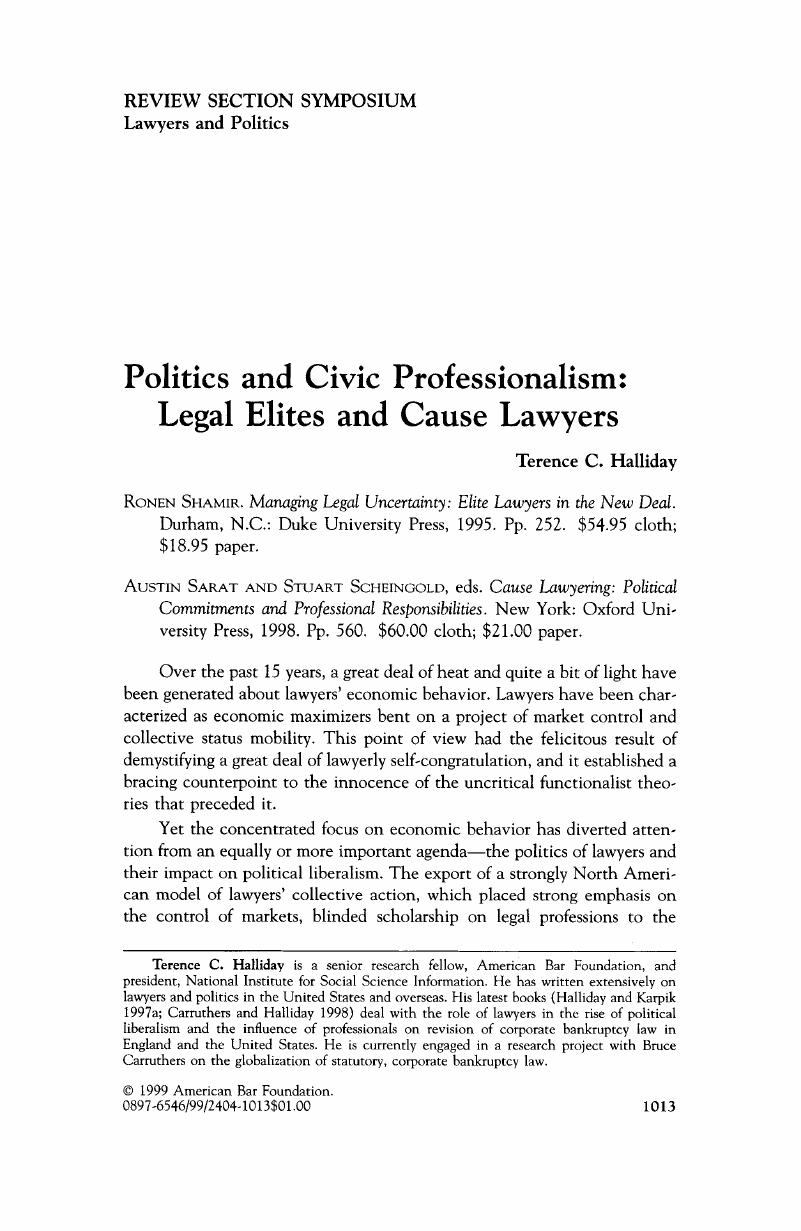Crossref Citations
This article has been cited by the following publications. This list is generated based on data provided by Crossref.
Bonelli, Maria da Gloria
2001.
Os desembargadores do Tribunal de Justiça do Estado de São Paulo e a construção do profissionalismo, 1873-1997.
Dados,
Vol. 44,
Issue. 2,
Bonelli, Maria da Gloria
2005.
Ideologias do profissionalismo em disputa na magistratura paulista.
Sociologias,
p.
110.
Liu, Sida
2006.
Client Influence and the Contingency of Professionalism: The Work of Elite Corporate Lawyers in China.
Law & Society Review,
Vol. 40,
Issue. 4,
p.
751.
Sharafi, Mitra
2007.
A New History of Colonial Lawyering: Likhovski and Legal Identities in the British Empire.
Law & Social Inquiry,
Vol. 32,
Issue. 4,
p.
1059.
Oliveira, Fabiana Luci
2008.
Justice, Professionalism, and Politics in the Exercise of Judicial Review by Brazil's Supreme Court.
Brazilian Political Science Review,
Vol. 2,
Issue. 2,
p.
93.
Wilson, Joshua C.
2009.
Studies in Law, Politics and Society.
p.
169.
Whiting, Amanda J.
2010.
Secularism, the Islamic State and the Malaysian Legal Profession.
Asian Journal of Comparative Law,
Vol. 5,
Issue. ,
p.
1.
Johnson, Bonnie J.
2011.
Creating Civic Bureaucrats.
International Public Management Journal,
Vol. 14,
Issue. 2,
p.
157.
Harding, Andrew
and
Whiting, Amanda
2012.
Fates of Political Liberalism in the British Post-Colony.
p.
247.
Da Ros, Luciano
2012.
Juízes profissionais? Padrões de carreira dos integrantes das Supremas Cortes de Brasil (1829-2008) e Estados Unidos (1789-2008).
Revista de Sociologia e Política,
Vol. 20,
Issue. 41,
p.
149.
Wilson, Joshua C.
and
Hollis‐Brusky, Amanda
2014.
Lawyers for God and Neighbor: The Emergence of “Law as a Calling” as a Mobilizing Frame for Christian Lawyers.
Law & Social Inquiry,
Vol. 39,
Issue. 02,
p.
416.
Marshall, Anna-Maria
and
Hale, Daniel Crocker
2014.
Cause Lawyering.
Annual Review of Law and Social Science,
Vol. 10,
Issue. 1,
p.
301.
Almeida, Fabio de Oliveira
2014.
A socialização da medicina na era do adhemarismo.
História, Ciências, Saúde-Manguinhos,
Vol. 21,
Issue. 4,
p.
1379.
Yusop, Farrah Dina
2016.
Asia Pacific Graduate Education.
p.
147.
Lee, Man Yee Karen
2017.
Beyond the ‘professional project’: The political positioning of Hong Kong lawyers.
International Journal of Law, Crime and Justice,
Vol. 50,
Issue. ,
p.
1.
Baumle, Amanda K.
2018.
LGBT Family Lawyers and Same-Sex Marriage Recognition: How Legal Change Shapes Professional Identity and Practice.
Journal of Homosexuality,
Vol. 65,
Issue. 14,
p.
2053.
Arrington, Celeste L.
and
Moon, Yong‐Il
2020.
Cause Lawyering and Movement Tactics: Disability Rights Movements in South Korea and Japan.
Law & Policy,
Vol. 42,
Issue. 1,
p.
5.
Bliss, John
2021.
Becoming Global Lawyers: A Comparative Study of Civic Professionalism.
Law & Social Inquiry,
Vol. 46,
Issue. 3,
p.
731.
Oliveira, Fabiana Luci de
2023.
Brazilian judges and the judicialization of corporatist interests.
Revista Direito e Práxis,
Vol. 14,
Issue. 4,
p.
2293.
Kwong, Ying-ho
2024.
The Legal Profession in Battle: Cause Lawyers Versus State-Embedded Lawyers in Hong Kong's Democratization.
Social & Legal Studies,



